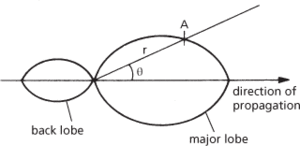A graph of the sensitivity or gain of a radio telescope in various directions. A typical antenna pattern shows several sensitivity maxima (lobes) of which the strongest (the main lobe or main beam) defines the direction in which the telescope is most sensitive. An antenna pattern with a narrow main lobe of circular cross-section and negligible side lobes is known as a pencil beam, while a pattern with a wide, flat main lobe is known as fan beam. See also Polar Diagram.
A diagram that represents the distribution of radiation in space from any source, such as a transmitting antenna, or conversely shows the effectiveness of reception of a receiving antenna. A practical antenna neither radiates nor receives equally in all directions. Its antenna pattern is a plot of relative gain as a function of direction, and may be made in terms of either its voltage response or power response; it may be produced in either polar or Cartesian coordinates. The antenna pattern for transmission is identical with that for reception.
A typical antenna pattern consists of one or more lobes that represent regions of enhanced response of an antenna in a particular plane. The main or major lobe is the lobe that contains the region of maximum radiation intensity or maximum sensitivity of detection of an antenna. It usually points forwards along the direction of propagation of the radiation. Other lobes are called side lobes. A back lobe is a lobe that points in the reverse direction to the direction of propagation. A typical antenna pattern is a polar figure of eight (see diagram). Point A (r, θ) on the diagram indicates the sensitivity of the antenna represented by r at an angle θ to the direction of propagation of the radiation.

Figure-of-eight antenna pattern
- model-based specification
- model checking
- modeless dialogue
- modelling
- modelling clip
- model numbers
- model organism
- model parameter
- Model Parliament
- model selection procedure
- model theory
- model validation
- modem
- modem optimizer
- mode of production
- moder
- moderated
- moderated newsgroup
- moderately repetitive DNA
- moderation
- moderator
- modern control
- modernism
- modernity
- modernization theory